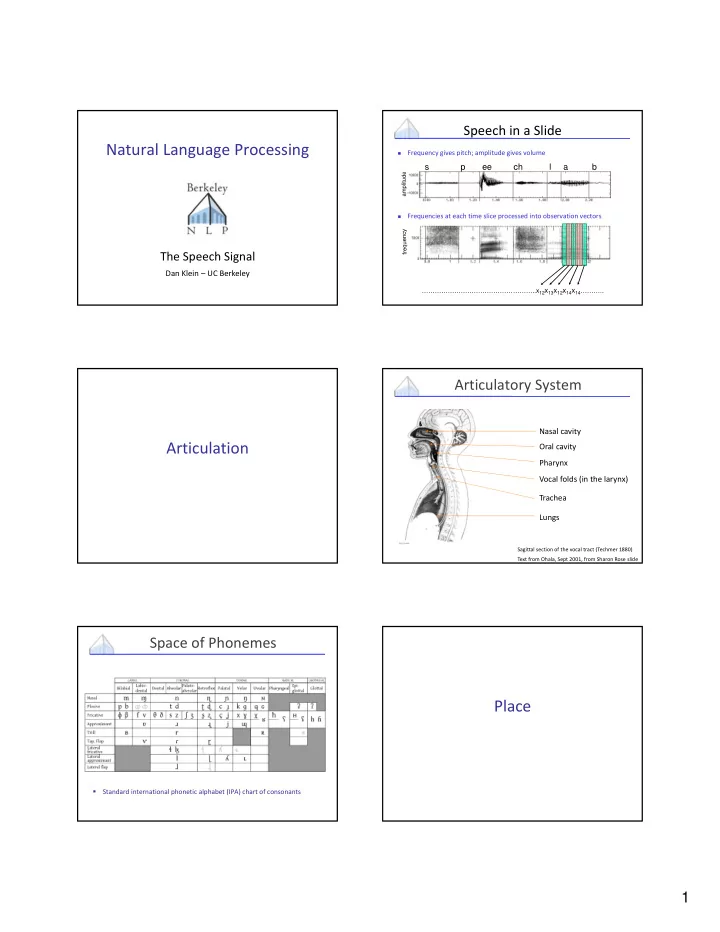

Speech in a Slide Natural Language Processing Frequency gives pitch; amplitude gives volume s p ee ch l a b amplitude Frequencies at each time slice processed into observation vectors The Speech Signal Dan Klein – UC Berkeley ……………………………………………..x 12 x 13 x 12 x 14 x 14 ……….. Articulatory System Nasal cavity Articulation Oral cavity Pharynx Vocal folds (in the larynx) Trachea Lungs Sagittal section of the vocal tract (Techmer 1880) Text from Ohala, Sept 2001, from Sharon Rose slide Space of Phonemes Place Standard international phonetic alphabet (IPA) chart of consonants 1
Places of Articulation Labial place alveolar post ‐ alveolar/palatal Bilabial: dental labiodental p, b, m velar Labiodental: uvular bilabial f, v labial pharyngeal laryngeal/glottal Figure thanks to Jennifer Venditti Figure thanks to Jennifer Venditti Coronal place Dorsal Place alveolar post ‐ alveolar/palatal dental velar Dental: uvular Velar: th/dh k/g/ng pharyngeal Alveolar: t/d/s/z/l/n Post: sh/zh/y Figure thanks to Jennifer Venditti Figure thanks to Jennifer Venditti Space of Phonemes Manner Standard international phonetic alphabet (IPA) chart of consonants 2
Manner of Articulation Space of Phonemes In addition to varying by place, sounds vary by manner Stop: complete closure of articulators, no air escapes via mouth Oral stop: palate is raised (p, t, k, b, d, g) Nasal stop: oral closure, but palate is lowered (m, n, ng) Fricatives: substantial closure, turbulent: (f, v, s, z) Approximants: slight closure, sonorant: (l, r, w) Vowels: no closure, sonorant: (i, e, a) Standard international phonetic alphabet (IPA) chart of consonants Vowel Space Vowels “She just had a baby” Acoustics What can we learn from a wavefile? No gaps between words (!) Vowels are voiced, long, loud Length in time = length in space in waveform picture Voicing: regular peaks in amplitude When stops closed: no peaks, silence Peaks = voicing: .46 to .58 (vowel [iy], from second .65 to .74 (vowel [ax]) and so on Silence of stop closure (1.06 to 1.08 for first [b], or 1.26 to 1.28 for second [b]) Fricatives like [sh]: intense irregular pattern; see .33 to .46 3
Time ‐ Domain Information Simple Periodic Waves of Sound 0.99 pat 0 pad –0.99 0 0.02 Time (s) bad • Y axis: Amplitude = amount of air pressure at that point in time • Zero is normal air pressure, negative is rarefaction • X axis: Time. spat • Frequency = number of cycles per second. • 20 cycles in .02 seconds = 1000 cycles/second = 1000 Hz Example from Ladefoged Complex Waves: 100Hz+1000Hz Spectrum Frequency components (100 and 1000 Hz) on x-axis 0.99 Amplitude 0 1000 100 Frequency in Hz –0.9654 0 0.05 Time (s) Part of [ae] waveform from “had” Spectrum of an Actual Soundwave 40 Note complex wave repeating nine times in figure Plus smaller waves which repeats 4 times for every large pattern 20 Large wave has frequency of 250 Hz (9 times in .036 seconds) Small wave roughly 4 times this, or roughly 1000 Hz Two little tiny waves on top of peak of 1000 Hz waves 0 0 5000 Frequency (Hz) 4
Back to Spectra Spectrum represents these freq components Computed by Fourier transform, algorithm which separates out each frequency component of wave. Source / Channel x ‐ axis shows frequency, y ‐ axis shows magnitude (in decibels, a log measure of amplitude) Peaks at 930 Hz, 1860 Hz, and 3020 Hz. Vowel [i] at increasing pitches Why these Peaks? F#2 A2 C3 Articulation process: The vocal cord vibrations create harmonics The mouth is an amplifier Depending on shape of F#3 A3 C4 (middle C) mouth, some harmonics are amplified more than others A4 Figures from Ratree Wayland Resonances of the Vocal Tract The human vocal tract as an open tube: Closed end Open end Length 17.5 cm. Air in a tube of a given length will tend to vibrate at resonance frequency of tube. Constraint: Pressure differential should be maximal at (closed) glottal end and minimal at (open) lip end. From Sundberg Figure from W. Barry 5
Computing the 3 Formants of Schwa Let the length of the tube be L F 1 = c/ 1 = c/(4L) = 35,000/4*17.5 = 500Hz F 2 = c/ 2 = c/(4/3L) = 3c/4L = 3*35,000/4*17.5 = 1500Hz F 3 = c/ 3 = c/(4/5L) = 5c/4L = 5*35,000/4*17.5 = 2500Hz So we expect a neutral vowel to have 3 resonances at 500, 1500, and 2500 Hz These vowel resonances are called formants From Mark Liberman Seeing Formants: the Spectrogram Vowel Space How to Read Spectrograms Spectrograms [bab]: closure of lips lowers all formants: so rapid increase in all formants at beginning of "bab ” [dad]: first formant increases, but F2 and F3 slight fall [gag]: F2 and F3 come together: this is a characteristic of velars. Formant transitions take longer in velars than in alveolars or labials From Ladefoged “A Course in Phonetics” 6
“She came back and started again” 1. lots of high ‐ freq energy 3. closure for k 4. burst of aspiration for k 5. ey vowel; faint 1100 Hz formant is nasalization 6. bilabial nasal 7. short b closure, voicing barely visible. 8. ae; note upward transitions after bilabial stop at beginning 9. note F2 and F3 coming together for "k" From Ladefoged “A Course in Phonetics” Deriving Schwa American English Vowel Space Reminder of basic facts about sound waves HIGH f = c/ iy uw c = speed of sound (approx 35,000 cm/sec) A sound with =10 meters: f = 35 Hz (35,000/1000) A sound with =2 centimeters: f = 17,500 Hz (35,000/2) ix ux ih uh ax FRONT BACK ao eh ah ae aa LOW Figures from Jennifer Venditti, H. T. Bunnell Dialect Issues American British Speech varies from dialect to dialect (examples are American vs. British English) Syntactic (“I could” vs. “I could all do”) Lexical (“elevator” vs. “lift”) Phonological Phonetic Mismatch between training and testing dialects can cause a large old increase in error rate 7
Recommend
More recommend